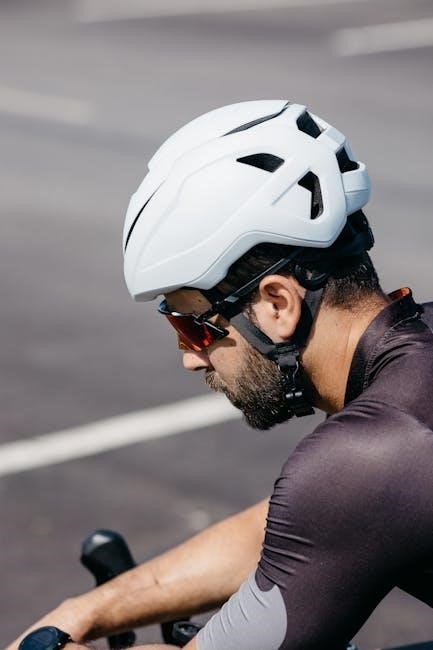Choosing the right men’s road bike size is crucial for optimal performance, comfort, and efficiency. Proper sizing depends on height, inseam, and personal riding style preferences.
Why Proper Bike Fit Matters
Proper bike fit is essential for comfort, efficiency, and performance. A well-fitted bike ensures optimal power transfer, reduces fatigue, and minimizes the risk of injury. An ill-fitting bike can lead to discomfort, pain, and poor control, making long rides tiresome and increasing the likelihood of accidents. By matching your body dimensions to the bike’s geometry, you achieve a more enjoyable and efficient riding experience. This alignment also enhances aerodynamics and handling, allowing you to ride farther and faster with confidence. A correct fit is the foundation of a great cycling experience.
Overview of Road Bike Sizing
Road bike sizing is determined by frame size, which is typically measured in centimeters and corresponds to the rider’s height and inseam. The process involves matching body dimensions to the bike’s geometry, ensuring optimal comfort and performance. Key factors include standover height, wheel size, handlebar reach, and saddle height. Proper sizing ensures efficient power transfer, better control, and reduced fatigue. Frame sizes usually range from 47cm to 63cm, catering to various rider heights. Understanding these measurements helps riders select a bike that aligns with their body proportions and riding style for an optimal experience.
Understanding Frame Size
Frame size is crucial for a comfortable and efficient ride, typically measured in centimeters and corresponding to rider height and inseam. While height is the primary factor, inseam and personal riding style also influence the fit.
What is Frame Size and How is it Measured?
Frame size refers to the length of the bike’s seat tube, measured from the center of the bottom bracket to the top of the seat tube collar. Typically measured in centimeters, it ranges from 47cm to 60cm for men’s road bikes. Rider height and inseam are primary factors in determining the correct size. Standover height and handlebar reach also influence fit. Proper measurement ensures optimal comfort, efficiency, and control while riding. A well-fitted frame size is essential for maximizing performance and minimizing discomfort or injury risks.
Frame Size vs. Wheel Size
Frame size and wheel size are distinct but related aspects of bike fit. The frame size is determined by the rider’s height and inseam, while wheel size impacts the bike’s handling and speed. Most men’s road bikes use 700c wheels, standard across sizes. Smaller frames may offer a more compact geometry, affecting standover height and ride comfort. While frame size is personalized, wheel size is typically uniform, ensuring consistent performance. Both factors together ensure the bike is suitable for the rider’s needs and preferences, optimizing both fit and functionality.

How to Measure Yourself for a Road Bike
To measure yourself for a men’s road bike, start by accurately measuring your height without shoes. Stand against a wall and mark the top of your head to ensure consistency. Next, measure your inseam by standing barefoot and determining the length from the floor to your crotch. Use these measurements to consult a size chart, which will guide you in selecting the appropriate frame size. This process ensures a proper fit, enhancing both comfort and performance while riding.
Measuring Your Height
Accurately measuring your height is essential for determining the correct road bike size. Stand barefoot with your back against a wall, ensuring the floor is level. Place a straight object, like a book, flat on top of your head. Mark the wall at the object’s base to record your height. Use a tape measure to record this in centimeters or inches. Ensure the measurement is taken consistently each time for accuracy. This height will be cross-referenced with a size chart to help narrow down the ideal frame size for your road bike.
Measuring Your Inseam
Measuring your inseam accurately is crucial for determining the correct road bike size. Stand barefoot and place a hardcover book flat against your crotch, ensuring it’s level. Press the book firmly against your body, simulating the bike saddle. Mark the top of the book with your hand, then measure from the floor to this mark using a tape measure. Record this measurement in centimeters. Repeat the process a few times to ensure accuracy. This inseam length helps determine the ideal frame size and standover height for your road bike, ensuring proper fit and comfort while riding.

Men’s Road Bike Size Chart
A men’s road bike size chart helps riders find their ideal frame size based on height and inseam. Common sizes range from 47cm to 63cm, catering to various rider heights. Charts typically correlate height ranges (e.g., 5’0″-5’3″) with frame sizes (e.g., 49-50cm). Inseam measurements also play a role, ensuring proper standover clearance. By aligning height and inseam with the chart, riders can select a bike that offers optimal comfort, efficiency, and control. Always consult the chart specific to the bike brand, as sizing can vary slightly between manufacturers.
Height to Frame Size Conversion
Height is a key factor in determining the right road bike frame size. Riders typically fall into size categories based on their height, with frame sizes ranging from 47cm to 63cm. For example, a rider measuring 5’0″-5’3″ (152-160 cm) usually fits a 49-50cm frame, while taller riders at 6’0″-6’3″ (183-191 cm) opt for 58-60cm frames. These conversions ensure proper fit, balance, and comfort. Always cross-reference height with inseam for accuracy, as individual body proportions can vary. Use a size chart specific to the bike brand for precise measurements.
Inseam to Frame Size Conversion
Inseam is a crucial measurement for determining the correct road bike frame size. Typically, inseam ranges from 67-71 cm for 47-49 cm frames, 73-77 cm for 51-53 cm frames, and 79-83 cm for 55-57 cm frames. This ensures proper standover height and riding comfort. Measuring inseam accurately by standing against a wall with a book provides precise results. Combining inseam with height measurements helps refine the fit. Always refer to the manufacturer’s size chart for specific conversions, as sizing can vary slightly between brands and models.

Standover Height and Its Importance
Standover height ensures safety and comfort by providing adequate clearance between the rider and the bike. Proper standover height guarantees a safe dismount and optimal riding position.
How to Calculate Standover Height
To calculate standover height, measure the distance from the ground to the top of the bike frame’s horizontal tube. Subtract 1-2 inches for road bikes to ensure proper clearance. This allows a safe dismount and prevents discomfort while riding. Use your height and inseam measurements as reference points for accurate sizing. Always consider personal comfort and riding style when finalizing your standover clearance to ensure the best fit for your needs.
Why Standover Height Matters for Fit
Standover height is crucial for ensuring a safe and comfortable riding experience. Proper clearance prevents discomfort and injury when dismounting or maneuvering the bike. A well-fitted standover height allows riders to maintain control and confidence while cycling. It also accommodates varying inseam lengths, ensuring the bike matches the rider’s body proportions for optimal performance.

Wheel Size and Its Impact on Fit
Wheel size affects a bike’s fit, with 700c being standard for road bikes. Larger wheels improve roll-over and stability, while smaller wheels offer agility and easier handling.
Common Wheel Sizes for Road Bikes
700c wheels are the standard for most road bikes, offering a balance of speed and efficiency. Smaller riders may prefer 650b wheels for better fit and comfort.
How Wheel Size Affects Bike Fit
Wheel size impacts bike fit by altering standover height and handling; Smaller wheels like 650b provide a lower standover height, improving fit for shorter riders. Larger 700c wheels enhance stability and speed for taller riders, making them ideal for most road bikes. Proper wheel size ensures optimal comfort and performance.
Handlebar and Saddle Height
Proper handlebar and saddle height ensure comfort and efficiency. Handlebars should align with elbows slightly bent, while saddle height allows a 25-30 degree knee angle.
Adjusting Handlebar Height for Comfort
Adjusting handlebar height is key for comfort and efficiency. Start by ensuring elbows are slightly bent, around 5-10 degrees, to reduce strain on shoulders and neck. Handlebars should be level or slightly lower than the saddle for optimal aerodynamics and control. Experiment with spacers or stem height to find the perfect fit. Proper alignment prevents discomfort and enhances performance during long rides. Always test adjustments on a short ride to ensure comfort and make fine-tune changes as needed. Comfortable handlebars improve overall cycling experience.
Setting the Correct Saddle Height
Correct saddle height ensures efficient pedaling and prevents discomfort or injury. Stand over the bike, place hands on handlebars, and lift one leg to the pedal. Adjust height until leg is almost fully extended at the pedal’s lowest point. A slight bend in the knee (around 10-15 degrees) is ideal. Use a tape measure or specialized tools to measure inseam and frame size alignment. Proper saddle height reduces strain on hips and knees, improving power and endurance. Always double-check adjustments for optimal performance and comfort during rides.
Proper sizing is key to an enjoyable cycling experience. Use height, inseam, and size charts to find your ideal fit, ensuring comfort and efficiency on every ride.
Final Tips for Choosing the Right Size
When selecting a men’s road bike, prioritize your height and inseam measurements. Use size charts as a guide but consider personal comfort and riding style. Test rides are essential to ensure the bike fits well and feels right. Adjustments to handlebars and saddle height can further customize your fit. Don’t hesitate to consult with experts at a local bike shop for personalized recommendations. Remember, the right size enhances performance, comfort, and overall cycling enjoyment.
Importance of Test Rides
Test rides are crucial for confirming the right bike size and fit. They allow you to assess comfort, handling, and performance in real-world conditions. Even if measurements align with size charts, personal comfort can vary. A test ride helps ensure the saddle height, handlebar reach, and overall ergonomics suit your body. It’s the best way to validate your choice and make necessary adjustments before finalizing your purchase. Always prioritize a test ride to guarantee a perfect fit and enjoyable cycling experience.
